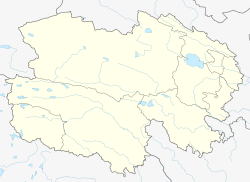Banma County
班玛县 · པདམ་རྫོངས། Baima | |
|---|---|
| Nickname: Pema (པདམ།) | |
 Banma County (division numbered "2") in Golog Prefecture | |
| Coordinates: 32°56′05″N 100°44′09″E / 32.93472°N 100.73583°E | |
| Country | China |
| Province | Qinghai |
| Autonomous prefecture | Golog |
| County seat | Sêlêtang |
| Area | |
| • Total | 6,376 km2 (2,462 sq mi) |
| Population (2020)[1] | |
| • Total | 31,794 |
| • Density | 5.0/km2 (13/sq mi) |
| Time zone | UTC+8 (China Standard) |
| Website | www |
| Banma County | |||||||||||
|---|---|---|---|---|---|---|---|---|---|---|---|
| Chinese name | |||||||||||
| Simplified Chinese | 班玛县 | ||||||||||
| Traditional Chinese | 班瑪縣 | ||||||||||
| |||||||||||
| Tibetan name | |||||||||||
| Tibetan | པདམ་རྫོངས། | ||||||||||
| |||||||||||
Banma County or Baima County is a county of southeastern Qinghai Province, China, bordering Sichuan to the south. It is the southernmost county-level division under the administration of Golog Tibetan Autonomous Prefecture. The Red Army of the Chinese Communist Party passed through Banma in 1936 during the Long March.[2] The seat of Baima county is in Sêlêtang.[2]
It is home to Bennak, a Nyingma monastery of the Pelyul tradition, founded in 1824, which was visited by noted female teacher Sera Khandro.[3] A 1992 work indicates that the 22 monasteries in the county are predominantly Nyingma.[4][5]
- ^ "果洛州第七次全国人口普查公报(第二号)——县级常住人口情况" (in Chinese). Government of Hainan Prefecture. 2021-07-09.
- ^ a b "新华网青海频道_青海新闻".
- ^ "Bennak". The Treasury of Lives. Retrieved 2018-10-02.
- ^ "pad+ma rdzong". Buddhist Digital Resource Center. Retrieved 2018-10-02.
- ^ "mgo log lo rgyus deb ther". Buddhist Digital Resource Center. Retrieved 2018-10-02.
